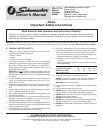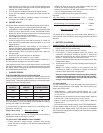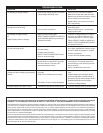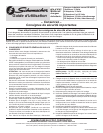
5
that has been run recently, turn on the vehicle’s headlights for
a few minutes before reading the meter to avoid getting a false
reading from a surface charge.
4. Turn off vehicle’s headlights and read the digital display.
5. To turn OFF the charger, unplug the power cord from the AC
wall outlet.
6. Disconnect the battery charging clamps as outlined in
“Charging Your Battery” on page 3.
H. ENGINE START
The Engine Start is a feature to help start the engine of your vehicle.
1. Plug the power cord into a 3-prong electrical wall outlet.
2. Push SELECT VOLT/CHARGE RATE button and choose 125A
START (6 volt) or 225A START (12 volt). The ENGINE START
feature will deliver 125 amps to help crank a 6-volt system and
225 amps to help crank a 12-volt system.
3. Push the symbol located in the Timer Set Time section until
the number 5 is displayed.
4. Crank the engine for no more than 5 seconds. If it does not
start, wait three minutes before cranking again for no more
than 5 seconds.
NOTE: During extremely cold weather, or if the battery is
severely exhausted, charge the battery for about 5 minutes in
the 40 amp setting before cranking the engine.
5. After the engine starts, unplug the charger power cord from
the wall outlet.
6. Disconnect the output clamps from the battery.
7. Clean and store the charger in a dry location.
IMPORTANT: Do not try to start the engine without a battery in it.
You could cause damage to the electrical system.
If the engine does turn over, but never starts, there is not a problem
with the starting system. There is a problem somewhere else with
the vehicle. STOP cranking the engine until the other problem has
been diagnosed and corrected.
I. CHARGE PERIOD
THE HYDROMETER OR ELECTRONIC METHOD
To nd the time needed to fully charge your battery, determine the
battery’s charge level with a hydrometer or electronic Percent-of-
Charge Tester. The following table will help you convert hydrometer
readings to percent of charge values.
SPECIFIC
GRAVITY
PERCENT OF
CHARGE
PERCENT OF
CHARGE NEEDED
1.265 100% 0%
1.225 75% 25%
1.155 25% 75%
1.120 0% 100%
When you know the percent of charge and the Amp Hour (AH) rat-
ing of your battery, you can calculate the approximate time needed
to bring your battery to a full charge.
To convert Reserve Capacity to Amp Hours, divide Reserve Ca-
pacity by 2, and add 16:
Ampere Hour rating = (Reserve Capacity) + 16
(2)
NOTE: The Reserve Capacity can be obtained from the battery
specication sheet or the owner’s manual.
TO CALCULATE TIME NEEDED FOR A CHARGE:
• Find the percent of charge needed. (A battery at 50 percent
charge that will be charged to 100 percent needs another 50
percent (.50).
• Multiply the Amp Hour rating by the charge needed (.50) and
divide by the charger setting (2/20/40 amps).
• Multiply the result by 1.25 and you’ll have the time needed, in
hours, to bring the battery to full charge.
• Add one additional hour for a deep-cycle battery.
Example:
Amp Hour Rating x % of charge needed x 1.25 = hours of
Charger Setting charge
100 (AH Rating) x .50 (charge needed) x 1.25 = 4.16666
15 (Charger Setting) hours
100 x .50 = 3.3333 x 1.25 = 4.16666
15
You would need to charge your 100-Ampere Hour Battery for a
little more than 4 hours at the 20-Amp charge rate using the above
example.
J. BATTERY CHARGING
CHARGER MUST BE ASSEMBLED BEFORE USING.
1. Before charging any battery, make sure the electrolyte (battery
liquid) in each cell is at correct level.
2. Set all buttons and timers to the OFF position.
3. If the battery is being charged inside the vehicle, use
connection procedures outlined in Section E. Should the
battery be removed from the vehicle, follow the instruction in
Section F. Plug the power cord into the AC outlet.
4. Set the charge rate switch to the desired charge position. See
Charge Rate Charts.
5. Set the timer from OFF position to desired timed charge, 30-
135 minutes.
NOTE: This battery charger is not automatic and can
overcharge a battery if permitted to operate for extended
periods of time. Monitor the charging often.
Also, your charger may exhibit a noise (buzzing) during charging.
Laminations of the transformer tend to vibrate. This is normal...
continue to charge the battery. The noise may continue after
charger is disconnected from battery.
The Chart Method
Use the following table to more accurately determine the time it
will take to bring a battery to full charge. First, identify where your
battery ts into the chart.
• Small batteries — motorcycles, garden tractors, etc. — are
usually rated in Ampere Hours (AH). For example: 6 to 12 AH,
or 12 to 32 AH.
• Batteries in cars and smaller trucks are usually rated in Reserve
Capacity (RC), Cold-Cranking Amps (CCA), or both.
• Marine, or deep-cycle batteries are usually rated in Reserve
Capacity (RC).
• NR means that the charger setting is NOT RECOMMENDED.
Find your battery’s rating on the chart on page 6 and note the charge
time given for each charger setting. The times given are for batteries
with a 50-percent charge prior to recharging. Add more time for severely
discharged batteries.


















